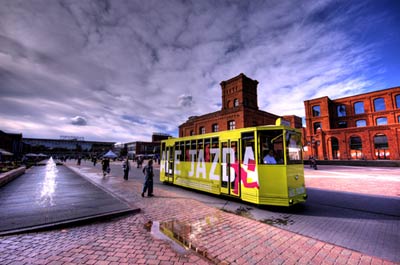ŁÓDŹ

Third biggest city in Poland (more than 740 thousand inhabitants) located in the very center of Poland and Europe. Intersection of important transport routes, major Polish motorway junction, where regular rail and aviation connections facilitate communication with the world.
In the early nineteenth century, Łódź began the process of transformation from a small town into the industrial metropolis. Crowds of settlers from all over Europe came to Łódź as to the "promised land" looking for work, eager for success, achieving their dreams and getting rich quickly.
Among the many cultures and religions the most visible were: Polish, Jewish, Russian and German. A kind of a new type of a citizen of Łódź evolved, the so-called “Lodzermensch”- persistent, industrious and entreprising person, for that the origin and religion ceased to play a role at a time when there was "business to be done" together. Thanks to such lodzermensch-Poznanski`s, Scheibler`s, Geyerer`s, Grohmann`s, Biedermann`s and Kindermann`s there were created factories, churches, social care institutions, villas and palaces.
Piotrkowska Street
The symbol of the city. This more than 4 km long street is the longest shopping street in Europe and the longest promenade in Poland. This was originally a medieval road leading to town Piotrków, then the axis along which the city granted its shape. Along with the rising of industrial fortunes there as well impressive residential premises rising. Today in Łódź you can enjoy more than 200 villas and palaces, which delight by the diversity of form and richness of exquisitely executed details. There was "in fahion" to have here a representation of the company, villa or shop. So many tastes, so many varieties of architectural buildings that can be seen adorning the street. Hence there are now perfectly preserved examples of eclecticism and Art Nouveau. Today Piotrkowska is still vibrant, there are many interesting places to see, wonderful, eclectic buildings and palaces, arcades, mysterious courtyards. This is a place where you can see the largest graffiti in Poland, ride a rickshaw or trambus (a replica of the historic tram). At Piotrkowska Street is the one and only "trampled" monument in Europe – the "Monument of Łódź` inhabitants on the turn of the millennium,"as well as the "Walk of Fame" with engraved in the pavement film celebrities names and an open-air gallery of monuments of Famous Łódź` Citizens. During the day Piotrkowska opens its doors for employees of banks, reputable companies and amateurs of cafés, restaurants and shops with a long tradition. In the evenings there are numerous cultural events held in various pubs and clubs and colorful nightlife goes along Piotrkowska Street.
Manufaktura centre
On the area of the former factory of Izrael Poznanski French investor has created a huge entertainment, shopping and culture complex, along with supermarkets, elegant boutiques, branch of the Museum of Art ms2, the four star design hotel Andel `s, 3D cinema, climbing wall, interactive Factory Museum, Experymentarium and many other attractions.
Priest's Mill
A unique place. Unusual "city within a city" created by the Scheiblers Family since the mid-nineteenth century, ruled by its own laws. Priest's Mill is one of the places where you can feel the atmosphere of the XIXth century Łódź. It housed factory workers' houses, school, fire station, shops and palaces of the owner and his family. Carl Wilhelm Scheibler was a German industrialist, one of three Łódź "cotton kings" and one of the richest men in Europe. He was so rich that even had private train and travelled from his palace through the trail connection Warsaw - Vienna. There are efforts underway to enter Priest`s Mill on the UNESCO list. Today, Priest's Mill is subject of regeneration. The old factories are being converted into exclusive apartments (lofts) and a business center. In the future there should be here a sort of creative district with a "mecca" for artists.
EC-1
The most recent and largest development project of the city is the revitalization of the entire quarter and streets surronding the EC-1 (90 hectars area). By the former power plant EC-1 there will be created, among others the World Art Center, David Lynch's film studio, the Museum of Technology. To implement this work the most prominent European architects have been invited.
